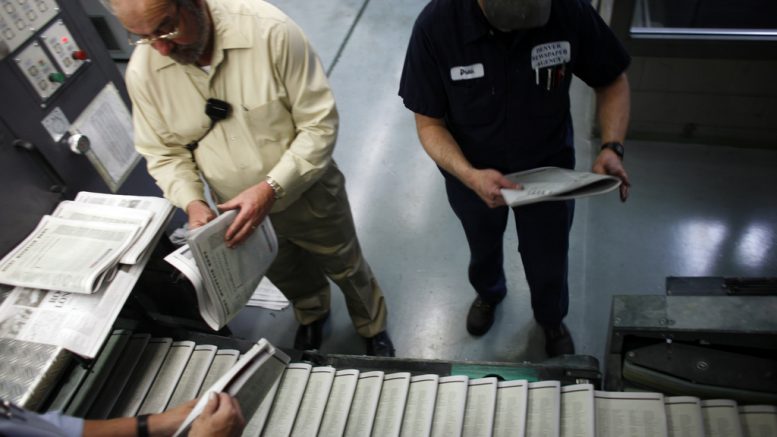NEW YORK (AP) — The decline of local news in the United States is speeding up despite attention paid to the issue, to the point where the nation has lost one-third of its newspapers and two-thirds of its newspaper journalists since 2005.
An average of 2.5 newspapers closed each week in 2023 compared to two a week the previous year, a reflection of an ever-worsening advertising climate, according to a Northwestern University study issued Thursday. Most are weekly publications, in areas with few or no other sources for news.
“My concern is that the acceleration that we’re seeing is only going to worsen,” said Tim Franklin, who heads the local news initiative at Northwestern’s Medill journalism school.
At its current pace, the country will hit 3,000 newspapers closed in two decades sometime next year, with just under 6,000 remaining, the report said. At the same time, 43,000 newspaper journalists lost jobs, most of them at daily publications, with the advertising market collapsing.
While digital outlets have emerged to fill some voids, they’re closing at roughly the same rate as new ones start, the report said. There is talk of public financing helping the industry, and more philanthropic money is coming in, but none of that has changed the trajectory.
Few media outlets are immune from financial concerns. The Washington Post said last month it needed to cut 240 jobs through voluntary buyouts, the website Jezebel said last week that it was closing, NPR is laying off employees, and The Associated Press this week began soliciting donations from readers.
The problems of local news, however, are like a slow drip that has affected every corner of the country.
There are 204 counties in the United States with no local news outlet, and 1,562 with only one, usually a weekly newspaper, the Northwestern report said. That’s more than half of the nation’s 3,143 counties. Northwestern placed 228 of the counties with only one news source on a “watch list,” declaring that single outlet endangered.
Texas, the nation’s second most populous state, has grown 50% since 2005 yet has lost 65% of its newspaper journalists, the report said.
“I don’t think there’s a demand problem for local news,” Franklin said. “I think there’s a supply problem. I don’t think there’s one solution to these problems. I think there are going to be multiple solutions.”
An uptick in local news readership during the pandemic shows people respond when there’s an urgent need to know what is going on in their communities, he said.
But the decline in local news has likely made many potential customers get out of the habit of looking for it. Job cuts at dailies have given rise to “ghost newspapers,” so-named because the product is a shadow of what it used to be, and readers have noticed.
The Alliance of Audited Media said that paid print and digital circulation at the 504 newspapers it has audited this year was 10.2 million. Print circulation alone for those newspapers was over 50 million in 2005.
Rural and poor areas are affected disproportionately, the report said. While new local digital sites have emerged in New York, Chicago, San Francisco and Boston, for example, most were based in more affluent, suburban communities with strong broadband access.
Studies have shown that the decline in local news has increased political polarization, led to more political corruption and let outlets that spread misinformation fill the void.
“What we’re trying to do is frame this as a crisis for democracy,” said Penny Abernathy, the report’s co-author and a Medill visiting professor.
Experts point to pockets of success. The Post and Courier of Charleston, S.C. has added 27 new reporters in markets across the state and hopes to have enough digital subscribers to support a statewide newsroom by 2025.
The Recorder, covering Bath, Highland and Alleghany counties in Virginia, was close to closing after more than 140 years when it doubled its subscription price to $99 in 2018. Readers stuck with it, and responded with donations to keep the newspaper afloat during the pandemic, the report said.
Northwestern also suggested public broadcasting as a potential avenue to more local news, while acknowledging that NPR and PBS have funding issues of their own.
“There is some growing awareness about this,” Franklin said. “There needs to be a lot more.”






































